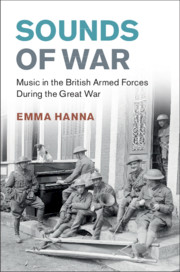Book contents
- Sounds of War
- Studies in the Social and Cultural History of Modern Warfare
- Sounds of War
- Copyright page
- Dedication
- Contents
- Figures
- Acknowledgements
- Abbreviations
- Introduction
- 1 Music in Britain, 1914
- 2 Recruitment and Fundraising
- 3 Instruments of War
- 4 Songs, Identity and Morale
- 5 Captivity
- 6 Religion and Pastoral Care
- 7 Medicine and Therapy
- 8 The Gramophone
- 9 Civilian Concert Parties
- 10 Servicemen’s Concert Parties
- 11 After the Armistice
- Conclusion
- Notes
- Sources and Select Bibliography
- Index
6 - Religion and Pastoral Care
Published online by Cambridge University Press: 20 February 2020
- Sounds of War
- Studies in the Social and Cultural History of Modern Warfare
- Sounds of War
- Copyright page
- Dedication
- Contents
- Figures
- Acknowledgements
- Abbreviations
- Introduction
- 1 Music in Britain, 1914
- 2 Recruitment and Fundraising
- 3 Instruments of War
- 4 Songs, Identity and Morale
- 5 Captivity
- 6 Religion and Pastoral Care
- 7 Medicine and Therapy
- 8 The Gramophone
- 9 Civilian Concert Parties
- 10 Servicemen’s Concert Parties
- 11 After the Armistice
- Conclusion
- Notes
- Sources and Select Bibliography
- Index
Summary
Examines the role of music in religious worship and pastoral care on the fighting fronts. It will show how the singing of hymns was a central feature of several organizations’ work in drawing men towards their religious services and pastoral care, and of how they were deployed in times of great stress. It will show how many of the voluntary-aid organisations combined their own brands of practical Christian philanthropy and pastoral care to servicemen as a ‘counter-attraction’ to keep men away from less salubrious pursuits, as well as to educate and civilize servicemen and labourers fighting for Britain
Keywords
- Type
- Chapter
- Information
- Sounds of WarMusic in the British Armed Forces during the Great War, pp. 114 - 141Publisher: Cambridge University PressPrint publication year: 2020

